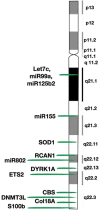Ten Reasons Why People With Down Syndrome are Protected From the Development of Most Solid Tumors -A Review
- PMID: 34804119
- PMCID: PMC8602698
- DOI: 10.3389/fgene.2021.749480
Ten Reasons Why People With Down Syndrome are Protected From the Development of Most Solid Tumors -A Review
Abstract
People with Down syndrome have unique characteristics as a result of the presence of an extra chromosome 21. Regarding cancer, they present a unique pattern of tumors, which has not been fully explained to date. Globally, people with Down syndrome have a similar lifetime risk of developing cancer compared to the general population. However, they have a very increased risk of developing certain tumors (e.g., acute leukemia, germ cell tumors, testicular tumors and retinoblastoma) and, on the contrary, there are some other tumors which appear only exceptionally in this syndrome (e.g., breast cancer, prostate cancer, medulloblastoma, neuroblastoma and Wilms tumor). Various hypotheses have been developed to explain this situation. The genetic imbalance secondary to the presence of an extra chromosome 21 has molecular consequences at several levels, not only in chromosome 21 but also throughout the genome. In this review, we discuss the different proposed mechanisms that protect individuals with trisomy 21 from developing solid tumors: genetic dosage effect, tumor suppressor genes overexpression, disturbed metabolism, impaired neurogenesis and angiogenesis, increased apoptosis, immune system dysregulation, epigenetic aberrations and the effect of different microRNAs, among others. More research into the molecular pathways involved in this unique pattern of malignancies is still needed.
Keywords: cancer; down syndrome; metabolism; microRNA; trisomy 21; tumor suppressor genes.
Copyright © 2021 Osuna-Marco, López-Barahona, López-Ibor and Tejera.
Conflict of interest statement
The authors declare that the research was conducted in the absence of any commercial or financial relationships that could be construed as a potential conflict of interest.
Figures


Similar articles
-
[Trisomy 21 and cancers].Morphologie. 2012 Oct;96(314-315):57-66. doi: 10.1016/j.morpho.2012.10.001. Epub 2012 Nov 7. Morphologie. 2012. PMID: 23141635 Review. French.
-
A genomic approach to study down syndrome and cancer inverse comorbidity: untangling the chromosome 21.Front Physiol. 2015 Feb 4;6:10. doi: 10.3389/fphys.2015.00010. eCollection 2015. Front Physiol. 2015. PMID: 25698970 Free PMC article.
-
A single extra copy of Dscr1 improves survival of mice developing spontaneous lung tumors through suppression of tumor angiogenesis.Cancer Lett. 2014 Jan 1;342(1):70-81. doi: 10.1016/j.canlet.2013.08.047. Epub 2013 Sep 16. Cancer Lett. 2014. PMID: 24051307
-
Chromosomal imbalance maps of malignant solid tumors: a cytogenetic survey of 3185 neoplasms.Cancer Res. 1997 Jul 1;57(13):2765-80. Cancer Res. 1997. PMID: 9205089
-
A tumor profile in Patau syndrome (trisomy 13).Am J Med Genet A. 2017 Aug;173(8):2088-2096. doi: 10.1002/ajmg.a.38294. Epub 2017 May 25. Am J Med Genet A. 2017. PMID: 28544599 Review.
Cited by
-
Inverse Comorbidity between Down Syndrome and Solid Tumors: Insights from In Silico Analyses of Down Syndrome Critical Region Genes.Genes (Basel). 2023 Mar 26;14(4):800. doi: 10.3390/genes14040800. Genes (Basel). 2023. PMID: 37107558 Free PMC article.
-
Shared chromosome 21q loss in a mixed subtype renal cell carcinoma: composite or collision tumor?Virchows Arch. 2025 May;486(5):1079-1083. doi: 10.1007/s00428-024-03820-w. Epub 2024 May 23. Virchows Arch. 2025. PMID: 38780616
-
Insights into the Clinical, Biological and Therapeutic Impact of Copy Number Alteration in Cancer.Int J Mol Sci. 2024 Jun 21;25(13):6815. doi: 10.3390/ijms25136815. Int J Mol Sci. 2024. PMID: 38999925 Free PMC article. Review.
-
Exploratory analysis of the proteomic profile in plasma in adults with Down syndrome in the context of Alzheimer's disease.Alzheimers Dement. 2025 Mar;21(3):e70040. doi: 10.1002/alz.70040. Alzheimers Dement. 2025. PMID: 40110647 Free PMC article.
-
Pharmacophore-Model-Based Virtual-Screening Approaches Identified Novel Natural Molecular Candidates for Treating Human Neuroblastoma.Curr Issues Mol Biol. 2022 Oct 13;44(10):4838-4858. doi: 10.3390/cimb44100329. Curr Issues Mol Biol. 2022. PMID: 36286044 Free PMC article.
References
-
- Aboudafir E. (2017). Trisomie 21: Perspectives actuelles de recherche de traitements. Sciences pharmaceutiques. Available at: https://hal.univ-lorraine.fr/hal-01932163/document .
-
- Araya P., Waugh K. A., Sullivan K. D., Núñez N. G., Roselli E., Smith K. P., et al. (2019). Trisomy 21 Dysregulates T Cell Lineages toward an Autoimmunity-Prone State Associated with Interferon Hyperactivity. Proc. Natl. Acad. Sci. USA 116 (48), 24231–24241. 10.1073/pnas.1908129116 - DOI - PMC - PubMed
Publication types
LinkOut - more resources
Full Text Sources

